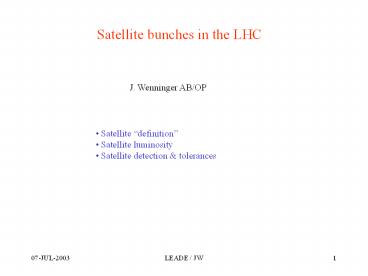Satellite bunches in the LHC PowerPoint PPT Presentation
1 / 7
Title: Satellite bunches in the LHC
1
Satellite bunches in the LHC
J. Wenninger AB/OP
- Satellite definition
- Satellite luminosity
- Satellite detection tolerances
2
Nominal proton filling
3
Satellites
- LHC bunch filling and RF
- Bunches are separated by a multiple of 25 ns.
- 400 MHz LHC RF system 1 RF bucket every 2.5 ns.
- ? room for 9 satellite bunches between the
nominal ones, spaced by 2.5 ns. - Satellite bunch formation
- Transfer from one machine to the next (PS ? SPS,
SPS ? LHC) - Un-captured beam ? lost at the beginning of
acceleration. - Beam captured in unwanted locations ? satellite
bunches. - Amount of un-captured beam /satellites depends on
- RF settings
- Longitudinal parameters emittance, bunch
length - Finally satellites must survive the ramp not
guaranteed.
4
LHC beam _at_ injection into SPS
injection
injection 1 second
Uncaptured beam
72 bunches from PS
- Un-captured beam up to 10
- Satellite bunches possibly level -
difficult to measure !
Note The main SPS RF system runs at 200 MHz.
5
Satellite bunch collisions luminosity
- IP1, IP2, IP5, IP8 collisions between
satellites every 2.5 ns (same vertex as nominal
bunches worst case 9 times more frequent than
normal collisions). - per collision Lsat r2 L r
satellite bunch int./normal bunch int. - IP8 / LHCb additional possibility of collision
between satellites normal bunches at the
beginning and end of each 72 bunch train. - per collision Lsat r L
- At all other encounters (upstream downstream of
IP) ? beams separated. - Totem no crossing angle ! Possible additional
collisions between satellite and normal bunches
every 37.5 cm on either side of IP.
6
Satellite Detection
- LHC
- A high sensitivity longitudinal profile monitor
should detect satellites at the per-mill level
within minutes. - Either level is OK, or re-filling (and possibly
retuning of the SPS and/or LHC RF system) may be
required. - For a good RF capture in the LHC there are
stringent requirements on transfer conditions
SPS-LHC (energy, time jitter, emittance, bunch
length). - SPS
- Satellite bunches present in the SPS are likely
to create satellites in the LHC. - So far measurements in the SPS are difficult and
limited to level. - Detection of satellites in the SPS may be used to
prevent injection into the LHC but that would
require new instrumentation / detection methods
that are so far not foreseen.
7
SatelliteTolerances
- Sensitivity of machine components
- So far the main concern is for the beam position
monitor (BPM) system. Systematic position errors
of 0.1 mm possible with r 5-10. Depends
strongly on the exact pattern. r 1-2 should be
acceptable - Note that errors on the BPM system may have
consequences on other systems (collimation). - Sensitivity of the Experiments
- Are satellites at level acceptable ? What is (a
reasonable) maximum ? - TOTEM must probably be considered a special case
that may need more careful treatment.
- Acceptable intensity levels for satellites have
consequences on requirements for instrumentation
(and eventually on beam quality interlocks) in
the SPS.

